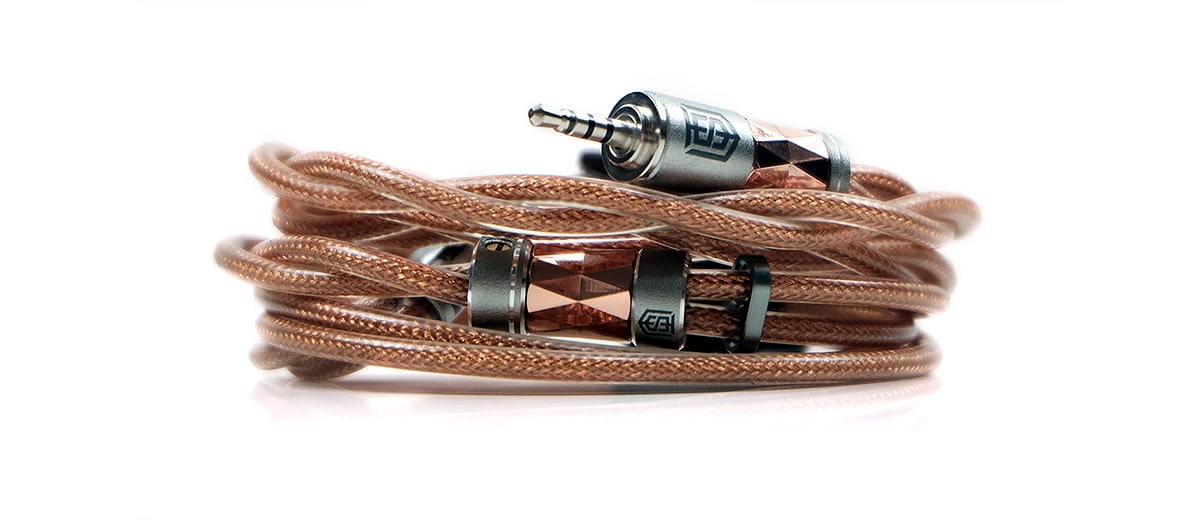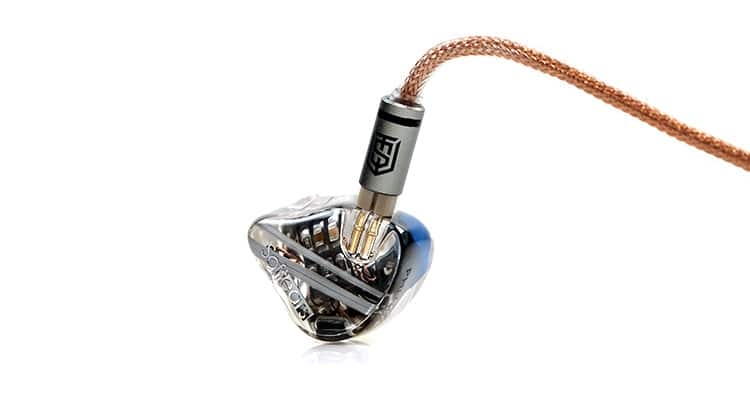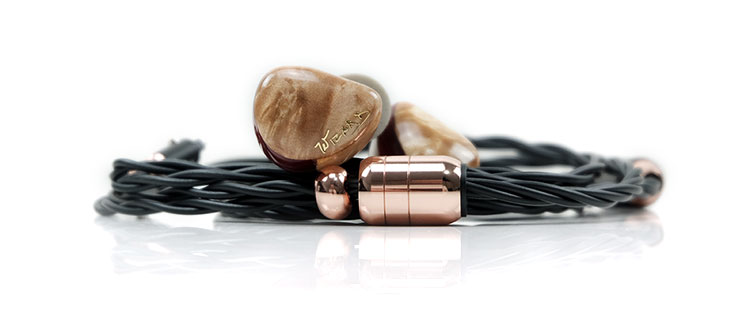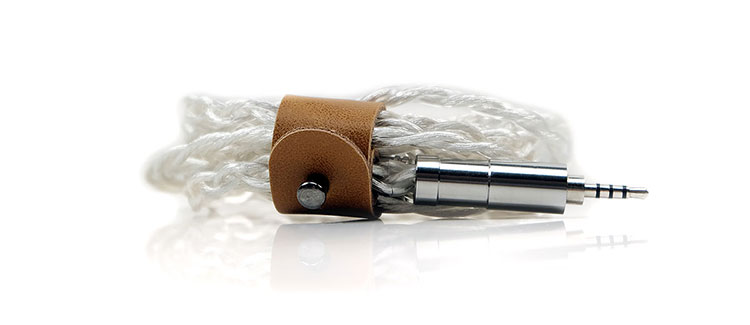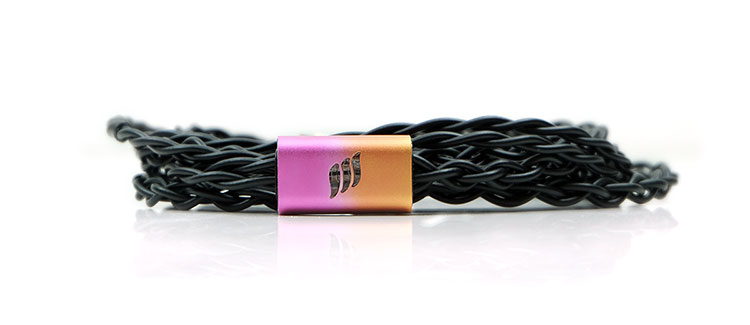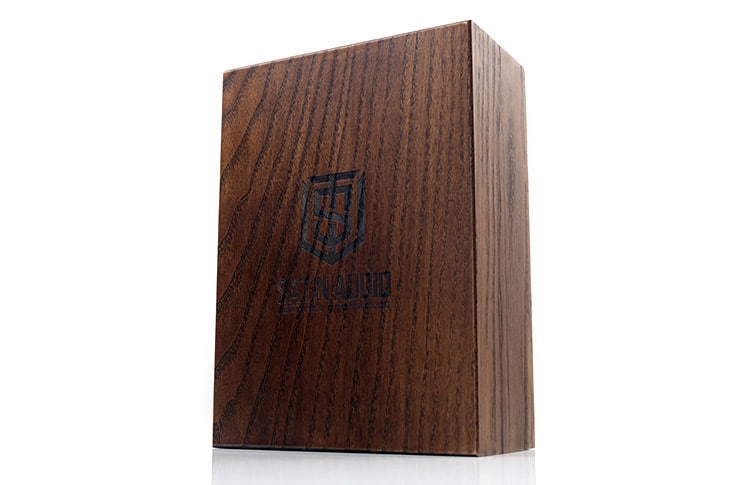Synergy
Perseus is really good at bringing some ‘calm’ to feisty IEMs. That is not to say it lacks power or body because the low-end is quite thick and well suited to a dynamic driver or hybrid monitors such as the UM MEXT.
Rather, it delivers that body and power in a slightly softish euphonic manner. It goes deep, very deep as a matter of fact, but it is not quite as aggressive or as punchy as something like the EVO 10. Rather more like a quality tube amplifier, it presents the bass experience in a more expansive or immersive manner.
Taking The Edge Away
The reference to taking the edge away comes from pairings with monitors with a high pinna gain or neutral to bright treble tuning. It will not cast a veil, nor will it suck out the air and compress the dynamics like a cheap copper 4-wire can do. Rather it just gently pulls back the leading edge and level of contrast to create a slightly more euphonic or romantic tone.
For example, the Softears RS10 sounds wonderfully inciteful with its clean reference sound signature and it carries with it a potent bass punch for a BA low-end. The Perseus pairing not only added some quality richness and depth to that punch but it smooths out the mids and highs a little more in the process producing a slightly more natural sound.
Another good example is the Empire Ears Odin. It has two signature traits that Perseus just loves, a strong dynamic driver bass response and a forward upper-mids that some can find edgy depending on their pairing.
The Perseus pairing really digs out a wonderful sub-bass quality with plenty of rich texture but at the same time, it’s not an in-your-face bass performance with that slightly liquid leading edge. It’s big, bombastic but not fatiguing. In the same manner, those forward upper mids smooth out a little so vocals, whilst they remain forward, sounding a shade warmer and more natural to my ear.
Intimacy Vs Expansive
While the dynamic range is on par with cables like the Reference Silver from Astral Acoustics, I did find that if you are a lover of midrange clarity and intimacy Perseus might come off second best.
Not that Perseus is unclear or muddy but rather it sounds relatively relaxed and more focused on delivering an expansive staging quality whereas cables like Reference silver drew you right in with IEMs such as the RS10 and the 64 Audio A18, which is a monitor known to have a slightly muted midrange section tuning.
The plus side is that the entire soundstage honestly felt very filled in and busier than cables such as the EVO 10 which tended to produce dominant bass and upper mids performances. Certainly, I felt Perseus was very competitive in teasing out plenty of spatial cues beyond the vocal and bass imaging experience with our test IEMs.
Select Comparisons
PLUSSOUND Copper+
Though it costs a bit more this is possibly one of the closest competitors given how each one has been designed. You can read our review of the Copper+ from last year here.
$999
Technical
This one caught my eye when I was sizing up the comparisons for Perseus. Not purely because of the fact both use OCC copper for their main wire but also because of the similar dual-core geometry though both companies use different nomenclature.
There are differences in the wire choices and perhaps some of the reasoning behind the Copper+ high price also. The first is the purity of their copper at UP-OCC rather than SP-OCC which normally means a confident 7N rather than Satin Audio’s definition of somewhere in between 6N and 7N purity level.
The second is the gauge with the Perseus using a mix of 23AWG and 26AWG in a 2-wire build whereas the Copper+ is all 24AWG for both cores in a 4-wire build. On balance, the Copper+ wiring is slightly thicker in some parts and smaller in others and with 4 as opposed to 2 wires.
So in one corner, we have the Perseus with its Geōmetria dual layer structure geometry and in the other corner, we have the Copper+ with its coaxial build. Different names but dig deeper and it’s a similar principle of a dual-core inner and outer with two layers of branded insulation.
Both are Litz-type builds with a single twist inner layer, and a braided outer layer though PLUSSOUND defines the outer in a bit more detail as being 5-strand bundled, also in a Litz configuration.
Design
This is where Perseus and Copper+ go their separate ways as there are quite a lot of design differences between them.
If there is one commonality it is the handling. With those thicker dual core wiring structures, they do feel heavier than normal and handle a little stiffer than your average 26AWG tightly braided PVC jacketed aftermarket cable.
Memory retention is quite low on both though there is some built-in curving, (by request), on the Perseus beyond the splitter to help shape the cable around your ear. The Copper+ has a natural bend in it also but here, one of the big differences comes into play, the external jacket.
The Perseus has by far the softer and more comfortable transparent jacket whereas the tightly twisted black jacket of the Copper+ makes it a little more disciplined but it feels firmer behind the ear for me. Because the Perseus jacket is transparent the aesthetics has more coppery pop, however, some might prefer the lower-profile black.
I would have preferred the Copper+ sample we have here with a silver barrel finish instead of the anodized aluminum barrels finished in rose gold chrome just to finish it off. Here is where I think Satin Audio got it just right with those crafted isosceles triangle bevel designs in a matching coppery tone. They complement the copper wire very nicely.
Still cannot beat the reliable PLUSSOUND connectors which are threaded and screwed tight as opposed to the smaller chrome barrels glued into place on the Perseus. They feel sturdier and more reliable for handling.
Performance
Both cables are very close in terms of general coloration with our tested IEMs. They both deliver a classic smooth, rich, and at times bass accentuated warmth with plenty of euphonic body in the lows.
However, there is a story to tell in this comparison journey and that is to avoid adaptors for your plugs if at all possible.
The two samples I have here are 4.4mm and 2.5mm TRRS terminated by default so when comparing on the same source I would use an adapter if the source does not have either a 4.4mm or 2.5mm output.
What I found was that the adaptors introduced additional changes in the dynamic response of each pairing. That was dominated by a diminished sub-bass performance of the Copper+ when paired with the A18 and the MEXT making it sound more neutral and lighter in the body.
My initial conclusion was that Perseus was the more dynamic and sub-bass heavy of the two cables since I did not use an adaptor for it.
Without the adaptors, the Copper+ sounded the slightly more dynamic of the two from both the MEXT and the A18 using the FiiO M17. The Perseus has equal weight and extension but sounded a little smoother, and not quite as upfront in the mids and highs. Though to be honest, the performance was fairly close.
Of the two, I would say that Perseus created the more euphonic and relaxed-sounding presentation, especially with the MEXT. The Copper+ seems to yield a bit more dynamic range and a slightly stronger treble presence.
That may well be due to the Copper+ core AWG size differences because you can pick out a little more vibrancy when the notes ping in and out on the tested monitors.
Astral Acoustics Reference Silver
$750
The Reference Silver was reviewed by us earlier in 2022 and has a price point not that far off Perseus. It presents a nice comparison for those debating the merits of pure copper or pure silver.
Technical
Both cables use two of the most popular single elements in cables, the Perseus with copper and the Reference Silver with, logically, silver.
The Reference Silver uses a pure 5N OCC Silver (T6 Ag) as opposed to the 6N-7N of the Perseus grade of SP-OCC copper but considering silver is generally a more expensive material, going higher might mean a significantly higher cost.
To compensate somewhat, the Reference Silver gauge is quite big at 23.5AWG and that’s the same gauge all the way through its traditional 4-wire Type 6 Litz geometry.
The Perseus Geōmetria dual layer structure geometry is very different with an inner Type 1 Litz twisted 26AWG core and an outer, and slightly larger, 23AWG braided layer for each of its 2 wires.
Both have fiber cores for stabilization but given the unique structure, the Perseus has additional layers of insulation between the two cores and a softer rubbery outer which gives it a thicker appearance per wire.
Design
This is more of a traditional versus the new and there are pros and cons to both in terms of handling and aesthetics. First, I love how both companies allow pure copper and silver to shine through transparent jackets. You cannot mistake the metals being used in either cable.
However, the jackets and braiding are quite different due to the different sizes of those finished wires. The Perseus is by far the thicker per wire and requires a soft long braid, almost a gentle twist to sit in place.
The Reference Silver braiding is the classic tighter styling with the thinner PVC jacket. It handles better compared to Perseus, more malleable with better flexibility as well but feels a little firmer when squeezed. The Perseus jacket is really soft and super comfortable to wear around the ear but does have a little more microphonics and weight compared to the Reference Silver.
I can’t knock the very tough and lightweight TA4 titanium barrels on the Reference Silver. They feel in keeping with the silver theme with plenty of confidence in the durability of the connector barrels in particular.
The finishing on the Perseus feels more ‘involved’ with the coppery isosceles triangle bevels on the splitter and jack grabbing your attention a bit more. It’s a more stylish finish for my tastes.
Performance
I am not hearing any distinct dynamic range difference between these two cables but there shouldn’t be too many surprises here in terms of expected tonal differences.
The Perseus does sound the smoother and more euphonic of the two cables when paired with the Softears RS10 and the UM MEXT. Whereas, the Reference Silver is the neutral pairing, a bit more revealing and vibrant in the mids and teasing out more treble presence.
The MEXT Perseus combo is a bit more obvious for the general lift in its low-end body with more sub-bass presence, bloom, and warmth. It does travel a little more into the mids timbre giving the whole performance a natural to slightly sweet overtone. Mids are not quite as cut and thrust, they do sound more relaxed but with a pleasing vocal harmonic balance.
The Reference Silver feels more upfront in general. I would hesitate to say it creates a more intimate staging quality but rather the volume sub-50Hz on the MEXT is less elevated and in return you get a tighter punchier sound. You will perceive it as the more articulate pairing but with the RS10 perhaps more exacting in finding natural sibilance as well.
The Perseus RS10 combo is much more forgiving when paired with the RS10 with percussion work slightly richer in body and more liquid on the leading edges.
It does lose a bit of the midrange energy and precision compared to the Reference Silver and it is not quite as sparkling or clean sounding. However, with a traditional pure copper build that should not be totally surprising.
Effect Audio EVO 10
$588
Our final cable is one of the recent mid-tier offerings from the ever-popular Effect Audio. The EVO 10 was reviewed by us back in early 2021 and you can read the full review here.
Technical
The EVO 10 has a mix of materials as opposed to Perseus’s use of a single copper split between 23AWG and 26AWG in a 2-wire configuration.
This is a 4-wire build with a smaller 26AWG UP-OCC Gold-Plated Copper and UP-OCC Silver-Plated Copper with individual strands of copper and silver rolled as one rather than 2 wires of copper and 2 wires of SPC.
Both are Litz configurations but highly customized. The EVO 10 uses EA’s classic Kevlar-infused ‘septupled’ (7) core bundled Litz geometry with the company’s brand new Surlyn insulation.
Whereas Perseus uses the newer Geōmetria dual layer structure geometry which has an inner Type 1 twisted Litz core and an outer braided core with insulation between the cores and around the outer core.
Design
As with the Reference Silver comparisons, this is very much a clash of tradition and new for design and aesthetics but this time you could argue that the EVO 10 has a lot more pop and attention to styling similar to Perseus.
The EVO 10 is definitely a smaller cable though, despite being 4-wire its smaller gauge and simpler core structure means the individual EA UltraFlexi™ insulation wrapped wires are much thinner. They are also a bit firmer to the touch compared to the spongier Perseus jacket.
That does mean that the EVO 10 wins in terms of handling being both lighter and not as stiff. You can feel the difference right away with the EVO 10 ‘melting away’ during use and not grabbing your attention as much. I will say, however, that Perseus is the more comfortable around the ear despite being heavier with that softer jacket material.
The styling differences show how inventive both companies have become with the Perseus going for the Greek-themed coppery isosceles triangle bevels on the splitter and jack barrels and the EVO 10’s detachable front splitter plates with different color schemes as well as the unique shape of the jack barrel.
One thing EA has introduced that I would love to see Satin Audio do is the ConX detachable connector system. With a choice of several connector types, it gives you more options for matching the EVO 10 to a wider range of IEMs whereas Perseus is limited to just one choice.
Performance
These two cables, when paired with the RS10, remind me a little of a good solid-state amp versus a good SETA tube amplifier.
The EVO 10 is more upfront but in a way that emphasizes the bass punch and power combined with a clean and sparkling treble performance. That in turn, creates a slightly drier tone for instruments and vocals with more bass/treble contrast from the RS10.
Whereas Perseus is richer and warmer in its coloration, offering a more natural sound with a laid-back dispersed feel through the RS10 mids and treble. It’s not neutral imaging versus a forward image but rather the Perseus sounds the more filled-in and information-rich of the two cables for background spatial cue articulation.
The EVO 10 seems curter with what it wants to reveal with the RS10 delivering a narrower and more focused upper mids percussion presence on the RS10. It sounds somewhat frugal for everything else above and behind though when it does come out it’s relatively smooth sounding.
That means your ear tends to hear how the RS10 performs primarily for the bass punch and the vocal/percussion presence. It’s a dynamic performer, however, much like a solid-state amp with a very clean background between the notes and some great low-end energy.
The Perseus is bass full, but its more voluptuous warmth and sub-bass body. Beyond, it is more atmospheric and dispersed in its delivery with the RS10 creating a much broader presentation. Quite how I normally perceive a good SETA amplifier’s performance.
Our Verdict
The Satin Audio Perseus is true to its copper heritage with a sumptuous and pleasingly euphonic performance with our tested monitors. It’s a cable that has a panache for relaxing the edge out of feisty IEMs but at the same time upping the quality and fulsomeness of the low-end.
This is the second dual-core copper cable we have reviewed in the last year with the first from PLUSSOUND with their Copper+. And like the Copper+, this is a thicker cable that handles a bit heavier and stiffer than previous designs.
The design though is striking with a strong copper shine to the cable itself and some very intricate barrel machining to complete the intriguing aesthetics.
Neither is this simply a duplicate performer with a cheaper pricing structure. The Satin Audio creation has its own persona and something that will appeal to those who want some of that relaxed tube-like timbre from their headgear.
Satin Audio Perseus Specifications
- Dual 23AWG/26AWG
- Superior Pure OCC Material
- High Audio Grade Premium Pure Copper
- Geōmetria Dual Layer Structures
- Double Insulation
- Kevlar Damping Core
- Premium SA Palladium Plated UCopper 2.5mm/3.5mm and Pentaconn OFC 4.4mm as standard plugs

